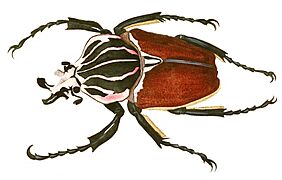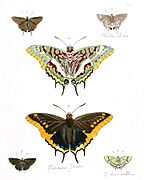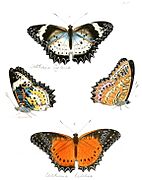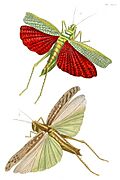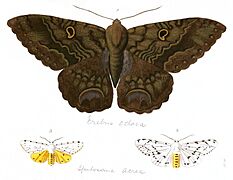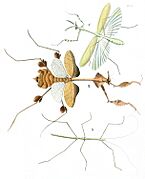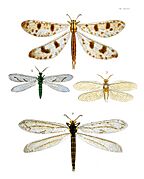Dru Drury facts for kids
Quick facts for kids
Dru Drury
|
|
|---|---|
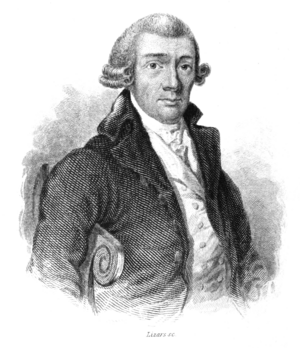
From Jardine's The Naturalist's Library
|
|
| Born | 4 February 1724 Wood Street, London, England
|
| Died | 15 December 1803 Turnham Green, London, England
|
| Spouse(s) | Esther Pedley |
Dru Drury (born February 4, 1725 – died December 15, 1803) was a British collector of natural history items and an entomologist. An entomologist is a scientist who studies insects. Drury became famous for his large collection of insects from all over the world. He got these specimens from a network of ship officers and other collectors. Many scientists used his collection to find and name new insect species. He is best known for his book, Illustrations of natural history, which showed and described many insects. This book was published in parts between 1770 and 1782, with most of the detailed pictures made by Moses Harris.
Contents
Dru Drury's Life Story
Dru Drury was born in Wood Street, London, England. His father, also named Dru Drury, was a goldsmith and silversmith in London. A goldsmith makes things out of gold, and a silversmith works with silver.
Becoming a Silversmith
In 1739, Dru Drury started learning the family business from his father. He became a full member of the Goldsmith's Company in 1751. In 1748, he married Esther Pedley. Later, he took over his father's business. He also owned several houses in London and Essex. By 1771, he was earning a lot of money.
Facing Challenges and Retirement
Even though he was wealthy, Drury faced some financial problems in 1777. Luckily, his friends, including Joseph Banks and John Fothergill, helped him. He continued his business for a while but decided to retire in 1789. After retiring, he spent all his time studying insects.
Dru Drury and his wife had three children: Mary, William, and Dru. William followed in his father's footsteps and became a silversmith. Drury spent his retirement years collecting insects in London and Hertfordshire. He faced health problems and passed away in 1803.
His Work in Natural History
Dru Drury was very interested in insects even before he stopped working as a silversmith. He was the president of the Society of Entomologists of London from 1780 to 1782. He was also a member of the Linnean Society, which is a famous group for natural history.
Collecting Insects from Around the World
Starting in 1770, Drury wrote letters to many entomologists and collectors worldwide, from India to Jamaica and America. He even offered money for any insect, no matter the size, from officers on merchant ships traveling far away. He also created a guide with instructions on how to collect insects. This is how he gathered most of his huge collection.
For example, he corresponded with a collector named Henry Smeathman who was in Africa. Smeathman sent back many amazing insects, some of which were completely new species.
His Famous Book: Illustrations of Natural History
From 1770 to 1782, Drury published his most important work, Illustrations of Natural History, Wherein are Exhibited Upwards of 240 Figures of Exotic Insects. This book had detailed copperplate pictures made by Moses Harris and Peter Mazell. It was later updated and republished as Illustrations of Exotic Entomology in 1837.
The original drawings for this book, made by Moses Harris and Mary Gartside, were recently found in Virginia, USA.
The Goliath Beetle Story
Drury was especially keen to find a specimen of the Goliath beetle, which is a very large and impressive insect. Another scientist, William Hunter, had a specimen and had drawings made of it. Drury later got these drawings, and the beetle was named Goliathus druryi in his honor. Drury then searched for another specimen himself, and one was sent to him by Henry Smeathman.
Drury also had other interests, like studying rocks and minerals, especially how gold was found around the world. He also enjoyed gardening, fishing in the River Lea, and even making his own wines.
Drury's Amazing Collection
Drury's insect collection was huge, with over 11,000 specimens! Many new species were described and named by famous entomologists like J.C. Fabricius and Kirby using his collection.
People at the time said that while some collections might have more of one type of insect, Drury's collection had an incredible variety of different kinds. They also noted that his specimens were in excellent condition. Many of them were unique and very valuable, especially those from places where it was dangerous for collectors to go. Famous scientists like Carl Linnaeus and Fabricius used his collection for their own studies, showing how highly they valued it.
After Drury passed away, his collection was sold at an auction. It brought in a good amount of money, including extra funds for his cabinets and books. However, the collection lacked detailed information about where each insect was found. This makes it hard for today's scientists to use the collection for some types of research.
Images for kids
- Plates from ''Illustrations of Exotic Entomology''
-
Black witch and salt marsh moths
-
Mantids and walkingstick
See also
 In Spanish: Dru Drury para niños
In Spanish: Dru Drury para niños



